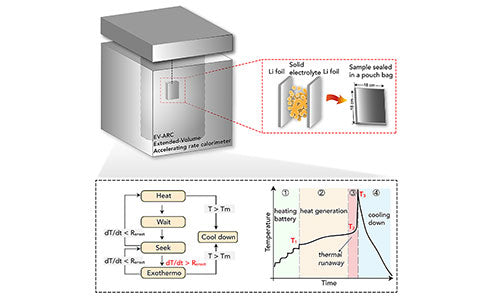
The thermal stability of the electrolyte is closely related to the safety of the battery. There are several reasons why the thermal stability of the electrolyte must be carefully considered. First, the temperature environment in which most lithium-ion batteries work is variable. Many liquid electrolyte batteries now need to work at temperatures as high as 60°C or even 80°C, but sometimes they are required to be able to work in a temperature environment as low as -40°C (such as military batteries or batteries used in some spacecraft). Second, some power-type lithium-ion batteries can reach temperatures of 400℃ or higher during normal operation. Therefore, the safety of the electrolyte at these temperatures has become an issue that must be considered when designing battery safety and cycle life. Third, the positive electrode of the battery often releases oxygen or has strong oxidizing properties under overcharge conditions, and most of the organic solvents currently used are flammable. In this case, the thermal stability of the electrolyte is particularly important. To ensure the safety of the battery, one depends on the separator, the other on the electrolyte, and the third on the electrode material, especially the safety and thermal stability of the positive electrode material. When a separator without a thermal shutdown function is used, the safety of the battery depends on the thermal stability of the electrolyte and electrode materials.
At present, most of the electrolytes used in lithium-ion batteries are composed of LiPF6 and carbonate solvents. Due to the autocatalysis initiated by a small amount of ethanol and water, at a not too high temperature (80~100℃), the thermal decomposition reaction of the electrolyte will occur, and a large amount of highly toxic alkyl fluorophosphate will be produced. The use of lithium transition metal oxides or the addition of Lewis base to the electrolyte can prevent thermal decomposition from occurring.
As the number of cycles increases, the reactivity between the lithium-intercalated graphite and the electrolyte increases. After many cycles, the thermal stability of the battery is significantly reduced. The main reason is that the passivation layer gradually thickens. In addition, LixCoO2 cathode material also has a similar exothermic reaction trend. The smaller the value of x, the easier the exothermic reaction occurs, and the lower the temperature at which the exothermic reaction starts. Using a three-electrode system to observe the change of the open circuit voltage of LixCoO2 positive electrode, it is found that the thermal instability of LixCoO2 increases with the increase of the number of cycles and the decrease of the lithium content.
Thermal stability of LiPF6EC/DEC/DMC electrolyte between 40~350℃: There is an endothermic reaction of gas production due to the decomposition of DEC at about 170℃. As the temperature further increased, other reactions took place one after another. The released F ions react with alkyl carbonate molecules as bases and nucleophiles.
The main solid phase and liquid phase products of the solution thermal reaction are HO-CH2-CH2-OH, FCH2CH2-OH F-CH2CH2-F and polymers. The gas phase products mainly include PF5, CO2, CH3F, CH3CH2F and H2O. Someone used the DSC method to study the thermal decomposition reaction of the lithium-intercalated graphite electrode and the electrolyte. Three exothermic reaction peaks were observed at 130℃ (peak 1), 260℃ (peak 2) and 300℃ (peak 3) respectively. The total heat generated increases linearly with the increase of the amount of lithium inserted, and does not depend on the specific surface area of the graphite powder. Increasing the specific surface area of the electrode material reduces the appearance temperature of peak 2 and peak 3, but increases the exothermic amount of peak 1. Increasing the specific surface area accelerates the thermal decomposition reaction of lithium-intercalated graphite and electrolyte and the reaction at peak 1 (the peak 1 reaction is related to the formation of the passivation layer). Gas chromatography and FTIR studies have shown that the reaction at around 130℃ corresponds to the
Lithium-intercalated graphite decomposes to produce Li2CO3, while CO2 gas is generated during the process of heating the lithium-intercalated graphite to 130℃. It can be considered that the alkyl carbonate is first generated on the surface of the graphite electrode, and then the lithium alkyl carbonate is immediately decomposed to produce more stable Li2CO3.
Compare the thermal stability of three different cathode materials LiCoO2, LiNi0.1Co0.8 Mn0.1O2, LiFePO4 in the solvent EC/DEC and 1.0mol/L LiPF6 EC/DEC electrolyte or 0.8mol/L LiBOB EC/DEC electrolyte . First charge the cathode material to 4.2V. In the EC/DEC solvent, the starting temperature of the self-sustaining exothermic reaction of LiCoO2, LiNi0.1Co0.8Mn0.1O2 and LiFePO4 is 150℃, 220℃ and 310℃, respectively. In the electrolyte LiPF6 EC/DEC or LiBOB EC/DEC, LiNi0.1Co0.8Mn0.1O2(particle diameter 0.2μm) shows higher stability than LiCoO2 (particle diameter 5μm). The reactivity of these two charged state cathode materials with LiBOB EC/DEC electrolyte is stronger than that with LiPF6 EC/DEC. But for the charged LiFePO4, LiBOB EC/DEC shows a higher thermal stability ratio than LiPF6 EC/DEC electrolyte. Since the reactivity of lithium-intercalated graphite with LiBOB electrolyte is not as high as with LiPF6-based electrolyte, these results indicate that graphite/LiBOB-based electrolyte/LiFePO4 lithium ion batteries can withstand improper use of the battery.
















